How to Organize a Small Closet: Space-Saving Tips

Let's be honest, staring into a cramped, overflowing closet is a frustrating way to start any day. But transforming that small space into a model of efficiency is more achievable than you might think. The key is to stop looking for quick fixes and start building a real, sustainable organization strategy.
This entire process boils down to three core actions: aggressively decluttering what you don't need, strategically planning your new layout to use every inch, and then implementing smart storage solutions. It’s about creating a lasting system, not just a temporary tidy-up.
Conquering Closet Chaos: A Practical Overview
We're going to walk through a proven process that focuses on three essential phases of closet organization:
- Culling your wardrobe to keep only what you genuinely love and actually wear.
- Designing a smart layout that takes full advantage of vertical and hidden spaces.
- Putting clever storage solutions to work that are tailored to what you own.
Think of this as your roadmap. Following it won't just get your small closet organized; it will create a system that genuinely simplifies your daily routine.
The Three-Phase Organization Process
The interest in home organization isn't just a fleeting trend. The global market for closet organizers was valued at around USD 12.5 billion in 2023 and is expected to hit nearly USD 19.8 billion by 2032. This growth is fueled by a collective shift toward more efficient living, especially in smaller homes where every square foot is precious. You can explore more data on closet organization market trends to see how this is playing out.
To give you a bird's-eye view, here’s a quick breakdown of the journey ahead.
Your Three-Phase Closet Organization Plan
| Phase | Key Action | Primary Goal |
|---|---|---|
| Phase 1: Declutter | Ruthlessly edit your wardrobe and remove everything that doesn't belong. | Create a clean slate with only the items you truly want and need. |
| Phase 2: Plan & Design | Measure your space and map out where everything will live. | Maximize every inch of available space, especially vertically. |
| Phase 3: Organize & Implement | Install your chosen storage solutions and put everything in its new home. | Build a sustainable, easy-to-maintain system for daily life. |
This simple flow shows you exactly how to tackle this project from start to finish.
The process is sequential for a reason. You have to evaluate and purge before you can even think about installing new shelves or hangers.
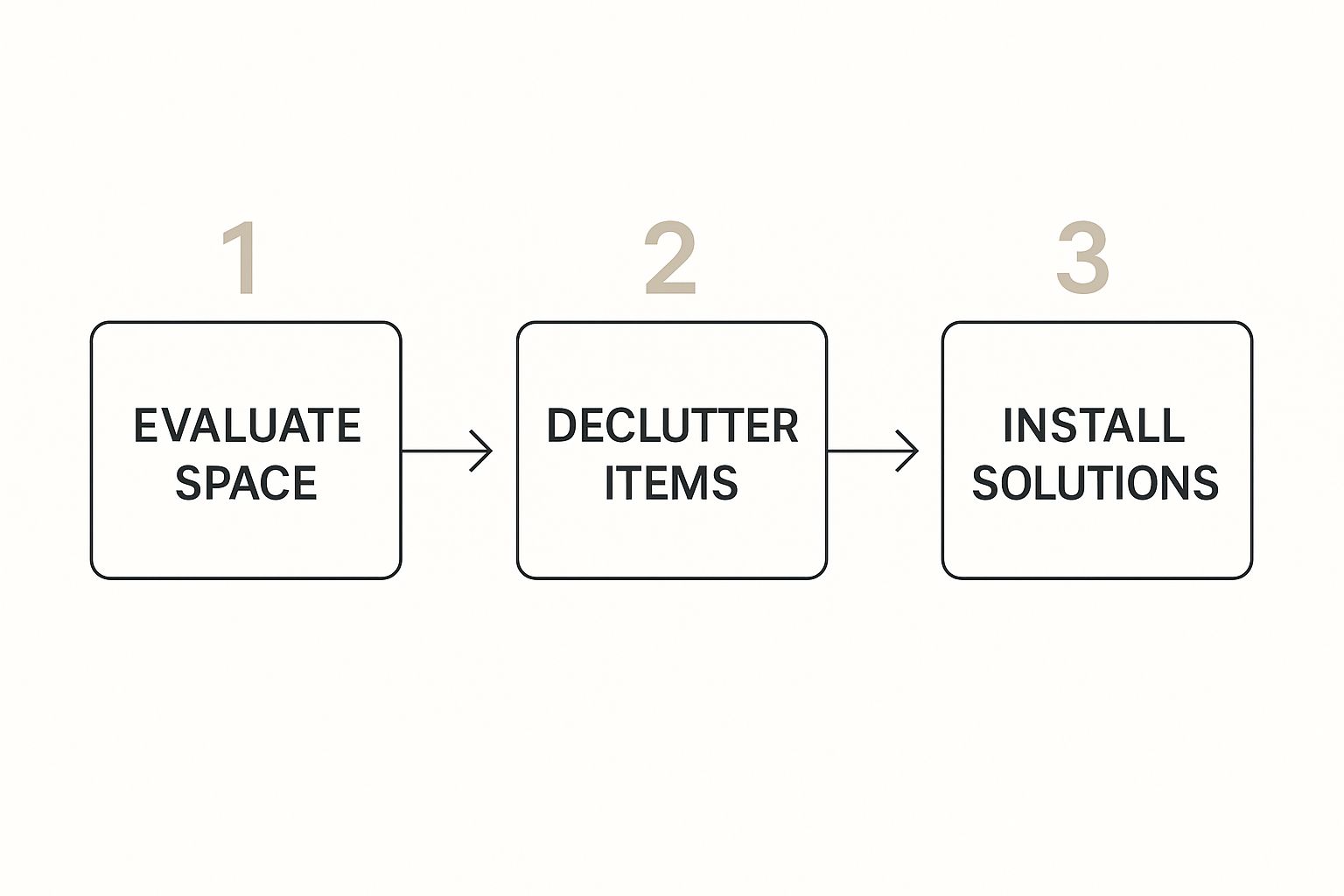
One of the most common mistakes people make is jumping straight to buying organizers, which almost always leads to disappointing, cluttered results. You have to do the prep work first.
Think of it as curating a space that works for you, not against you. An organized closet saves you time, reduces stress, and allows you to appreciate the items you've chosen to keep. It’s a real investment in your daily peace of mind.
First Things First: Declutter Your Wardrobe for Good
You can't organize clutter. It’s a simple truth, but it’s the absolute foundation of any successful closet makeover. Before you even think about new hangers or storage bins, the most important step is to honestly edit what you own. This isn't about becoming a minimalist overnight; it’s about creating a wardrobe that’s full of pieces you truly love and actually wear.
The process has to start with a clean slate. I mean a completely clean slate. Pull every single item out of your closet. Yes, every last shirt, pair of pants, and scarf tucked away in the back. This forces you to make a conscious decision about what earns its spot back inside, so you can't just ignore those forgotten items anymore.
The Four-Box Method: Your Decluttering Blueprint
To keep the chaos manageable, set yourself up with four boxes or distinct piles on the floor. Label them: Keep, Donate, Store, and Discard. This simple system gives every single item a clear destination, which makes the decision-making process so much faster.
Now, pick up each piece one by one, from that bridesmaid dress you wore once to your favorite old t-shirt. This is where you have to be brutally honest with yourself.
The real goal here isn't just to get rid of stuff. It's to build a wardrobe that works for your life right now. Letting go of clothes that no longer serve you literally makes space for a closet that feels intentional and easy to manage.
This methodical approach helps you avoid that classic decluttering mistake—shuffling items from one pile to another without ever making a final call. Each piece gets a verdict, once and for all.
The Litmus Test: Questions to Ask Yourself
To figure out what stays and what goes, you need a good filter. As you hold up each piece of clothing, run it through this checklist. It helps take the emotion out of the equation and lets you think logically.
- Does this fit me today? Not the you from five years ago or the you that you’re aiming for. If it doesn't fit comfortably right now, it’s just taking up precious real estate.
- Does this align with my current lifestyle? If you now work from home, that extensive collection of corporate-style blazers probably isn't serving you. Your clothes should support the life you actually live.
- Have I worn this in the last 12 months? Barring special occasion wear (like a tuxedo or a formal gown), if an item has sat unworn through four full seasons, it's highly unlikely you'll reach for it again.
- If I were shopping right now, would I buy this again? This is the killer question. It cuts right through any sentimental attachment or guilt and forces you to assess the item's value in the present.
Answering these questions honestly will make the sorting process feel less like a chore and more like an act of empowerment. You’re setting clear boundaries for what deserves a spot in your closet.
For a more in-depth look at this essential first step, our complete guide on how to declutter your closet walks you through even more strategies. Remember, tackling the emotional side of letting go is often the hardest part. It’s okay to release things you once loved—even expensive pieces. An item's true value comes from being used, not from just taking up space.
Creating a Blueprint for Your New Closet
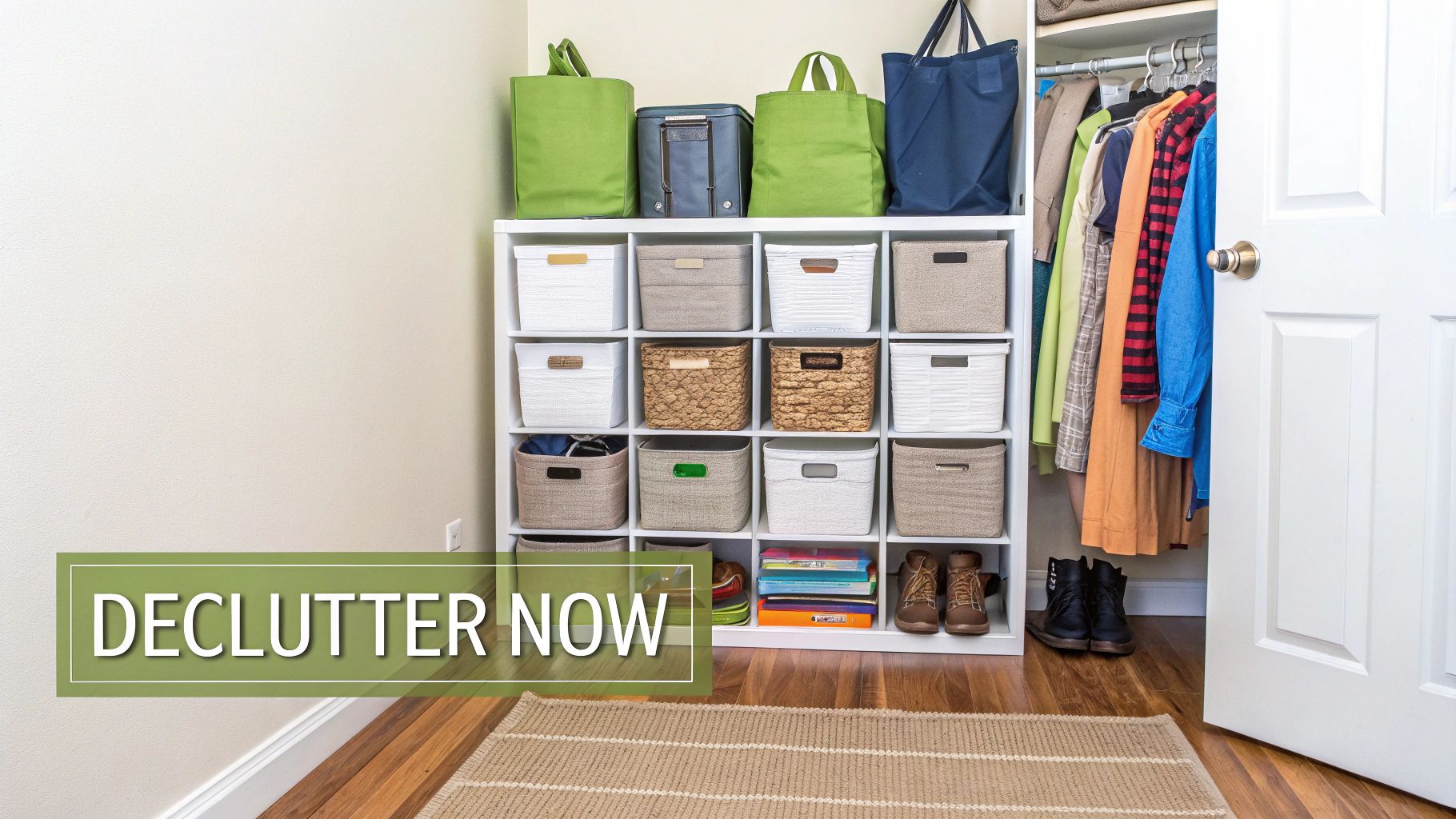
Now that you've decluttered, you can finally see the bones of your closet and its true potential. This is where the fun begins. We're moving from tidying up to a bit of closet architecture, creating a custom blueprint that makes every square inch work for you.
This planning stage is what separates a temporarily tidy closet from one that stays organized for good. So many people make the mistake of rushing out to buy bins and organizers without a plan, only to find they don't fit or don't solve the right problems. Let's avoid that.
Measure Everything First
Before you do anything else, grab a tape measure. You need to become an expert on your closet's specific quirks and dimensions.
Get the exact width, depth, and height. But don't stop there. Measure the vertical space between the existing rod and any shelves, and the clearance behind the door. These are your hidden opportunities for smart storage. You’d be surprised how much wasted vertical space most small closets have—that high shelf is perfect for off-season items, and the floor is prime real estate for a shoe rack.
Taking a few minutes to measure will save you the massive headache of ordering the perfect storage container only to discover it’s half an inch too wide. A solid plan built on accurate numbers is everything.
Once you've mapped out your space, you can turn a vague idea into a concrete project. You'll know exactly what can fit and where, which is a game-changer before you spend a single dollar.
Create Smart Zones for Your Clothes
Now, turn your attention to that "keep" pile. It's time to sort everything into logical categories that reflect how you actually live. This is more than just separating shirts from pants; it's about making your daily routine easier.
Think in terms of distinct groups that make sense for you. For most people, this looks something like:
- Workwear: All your office-ready clothes in one easy-to-find spot.
- Casual & Weekend: The go-to jeans, t-shirts, and comfy stuff.
- Workout Gear: Grab-and-go activewear for the gym or a run.
- Seasonal Items: Think bulky sweaters or sundresses that can be stored in less accessible areas when they're not in use.
With these piles created, you can start assigning them to specific "zones" on your closet blueprint. Maybe your work clothes hang in the most accessible spot on the rod, while seasonal items get stored on that high shelf. This strategy gives every single item a designated home.
For a deeper dive into creating functional layouts, our guide on how to design a closet has even more expert tips.
Choosing Your Space-Saving Tools
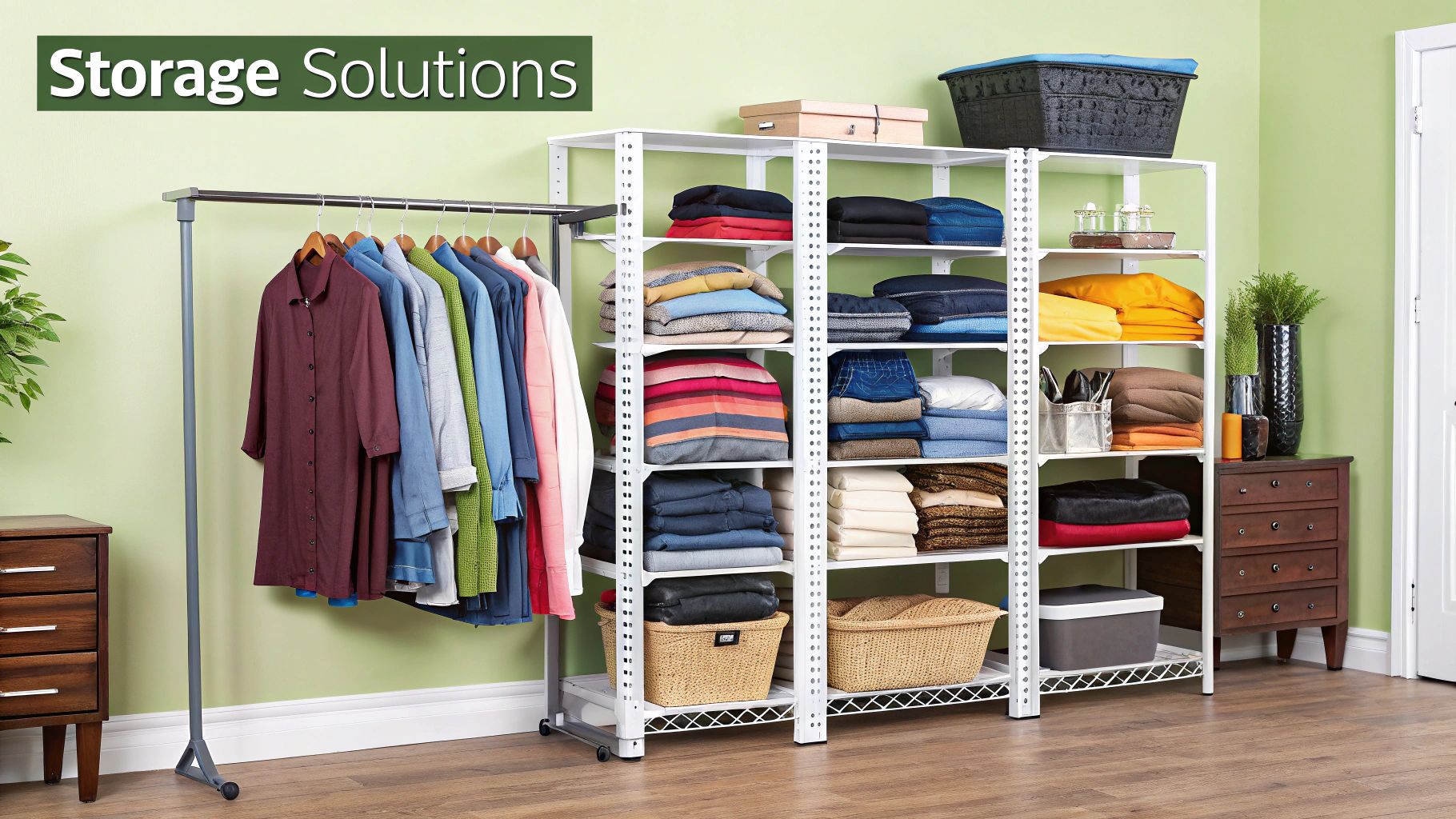
Alright, with a solid plan in place, it’s time for the fun part: picking the right tools for the job. This is where you get to translate your vision into a real, functional space. Instead of grabbing a random collection of bins and baskets, the key is to be strategic. Think about your specific pain points—is it the mountain of shoes on the floor or the bulky sweaters eating up shelf space?
The market for wardrobe and closet solutions is booming, valued at around USD 66.31 billion globally in 2024 and expected to grow. This surge is fueled by people in smaller homes and apartments who need smart organizers that make every inch count. This means there are more innovative products available now than ever before. You can read more about wardrobe market trends.
Start with Smarter Hangers
If you do only one thing, do this: upgrade your hangers. Seriously. Those clunky plastic hangers and the flimsy wire ones from the dry cleaner are space vampires. They create visual chaos and eat up precious rod space.
Making the switch to a uniform set of slim hangers is the fastest, most satisfying way to instantly create more room.
Slim velvet hangers are popular for a good reason. Their thin profile can magically free up to 30% more space on your closet rod. Plus, the non-slip surface means your silk tops and wide-neck sweaters actually stay put. No more finding them in a sad heap on the floor.
Want to take it to the next level? Multi-level hangers are absolute game-changers for certain items.
- Tiered Pant Hangers: These let you hang four or five pairs of pants in the same vertical space that one pair used to occupy.
- Cascading Hangers: These have a little hook that lets you "waterfall" your hangers, which is brilliant for grouping outfits together.
These are foundational tools for any small closet project. If you're not sure where to start, our guide on the best space-saving hangers breaks down all the options.
Embrace the Power of Vertical Space
Look up. Look down. Most small closets have a surprising amount of wasted vertical real estate—that empty air between your top shelf and the hanging rod, the space below your shirts, and even the back of the door. Your mission is to claim that space.
Hanging shelf organizers are perfect for bulky items like sweaters and jeans that don’t belong on hangers anyway. They require zero installation; just hang one from the closet rod, and you’ve got instant cubbies. This prevents those folded piles from becoming a toppling, messy tower.
The most overlooked asset in a small closet is often the door itself. An over-the-door organizer can store an incredible amount of stuff, from shoes and scarves to belts and handbags, all without taking up a single inch of interior closet space.
To help you decide which organizers will give you the most bang for your buck, here’s a quick comparison of some high-impact options.
High-Impact Closet Organizer Comparison
This table breaks down some of the most effective organizers to help you pinpoint the best solutions for your specific wardrobe and storage challenges.
| Organizer Type | Best For | Key Benefit |
|---|---|---|
| Slim Velvet Hangers | Uniformly hanging shirts, blouses, and dresses | Maximizes rod space and prevents clothes from slipping |
| Tiered Pant Hangers | Jeans, trousers, and slacks | Hangs 4-5 pairs in the space of one |
| Hanging Shelf Organizer | Folded sweaters, sweatshirts, and t-shirts | Creates instant, easy-access shelving |
| Over-the-Door Organizer | Shoes, scarves, belts, and accessories | Utilizes completely unused door space |
| Clear Shoe Boxes | Protecting and organizing individual shoe pairs | Keeps shoes visible, dust-free, and stackable |
Choosing a few of these key pieces, tailored to what you actually own, will make a much bigger difference than simply buying a bunch of generic bins.
See-Through Storage Is Your Best Friend
You know the saying, "out of sight, out of mind"? It’s especially true in a closet. If you can’t see what you have, you won’t wear it. This is why I always recommend clear storage containers over opaque ones.
For those items on the top shelf—like off-season hats or sentimental keepsakes—use clear acrylic or plastic bins. You can see exactly what’s inside without having to pull down three different boxes to find what you’re looking for.
And for shoes, clear drop-front shoe boxes are a fantastic solution. They stack neatly, protect your footwear from dust, and let you see your entire collection at a glance. No more digging through a pile on the floor to find a matching pair.
Putting It All Back Together: The Fun Part!
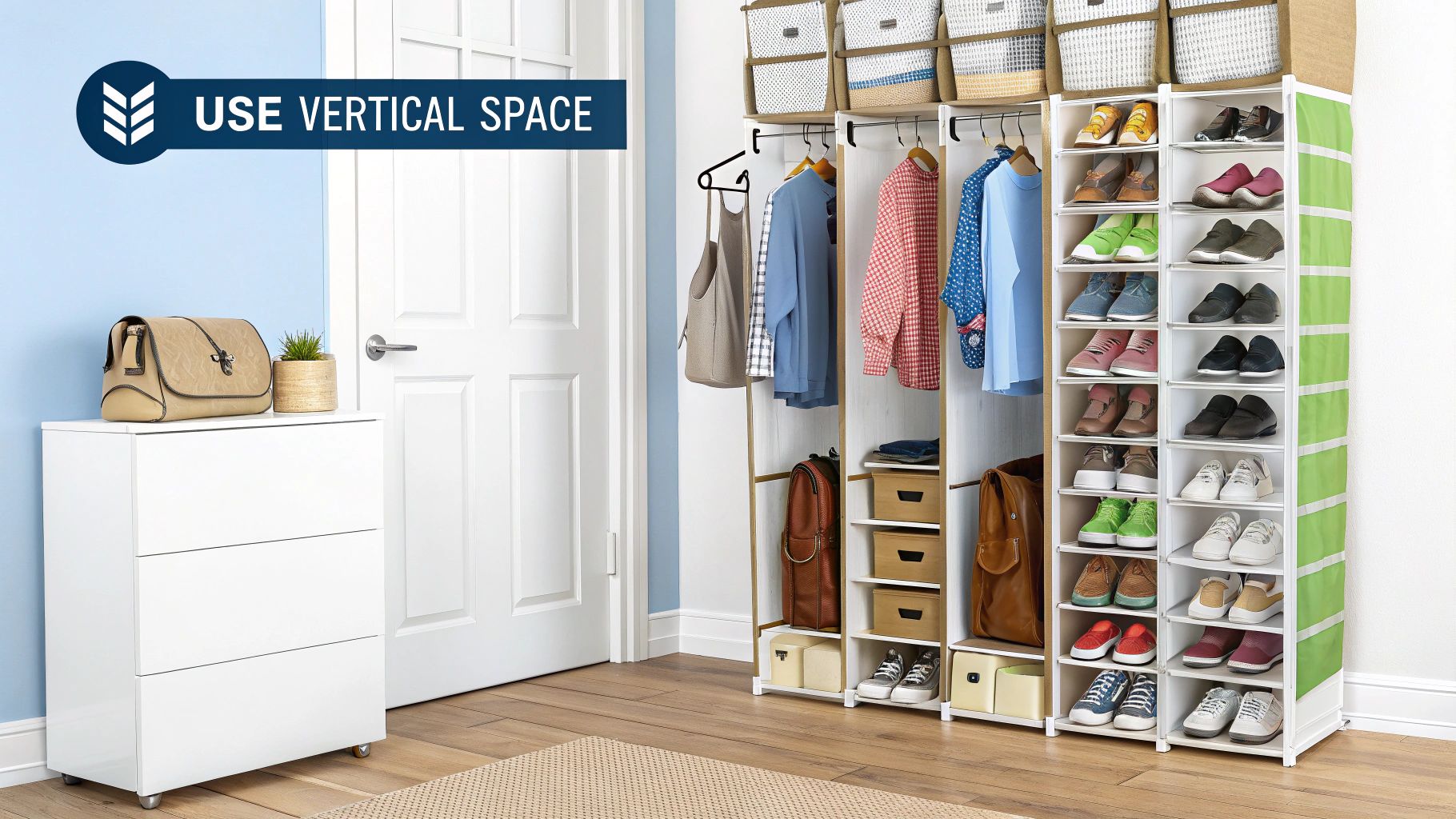
You’ve done the hard work of decluttering and have a solid plan in hand. Now comes the most satisfying part: actually assembling your new, hyper-organized closet. This is where the vision you’ve been working towards finally clicks into place. The trick is to put everything back with intention, creating a system that’s not just pretty to look at but also ridiculously easy to keep up with.
Let's start with your hanging items, since they take up the biggest chunk of visual and physical space. The first move is to group all your hanging clothes by category. All shirts go together, then all pants, then dresses, jackets—you get the idea. It sounds simple, but this one action will shave minutes off your morning routine. No more frantic searching!
Want to take it to the next level for that professional-organizer look? Once everything is grouped by type, arrange the items in each section by color. I like to follow the rainbow (think ROYGBIV) and then finish with neutrals, going from light to dark (white, beige, gray, and finally black). This creates a calm, clean look that makes even the tiniest closet feel more spacious and less chaotic.
Taming Your Shelves and Drawers
Next up, let's tackle those folded clothes. We all know how quickly a neat stack of sweaters can turn into a jumbled mess. This is where a change in folding technique can make all the difference. Ditch the traditional stacking method where you can't see what's at the bottom.
Instead, I swear by the file-folding method. You fold each item into a compact rectangle that can stand up on its own, like a file in a filing cabinet. When you line up your t-shirts, sweaters, or jeans this way in a drawer or a bin, you can see everything you own in a single glance.
The file-folding method isn’t just about making things look tidy; it’s about making them accessible. When you can see every single item, you're not only able to grab what you need without toppling a whole pile, but you're also more likely to wear all the clothes you decided to keep.
It’s a small shift that fundamentally changes how you use your wardrobe. Plus, it saves space and keeps wrinkles at bay.
Strategic Placement for an Effortless Routine
The final piece of the puzzle is putting each category into its designated zone. The golden rule here is accessibility.
- Prime Real Estate: Your most valuable closet space is what's easiest to reach—the front of the hanging rod and the shelves right at eye level. This is where your everyday heroes belong. Think work uniforms, your favorite jeans, the T-shirts you live in.
- Secondary Spots: Those hard-to-reach top shelves or the very back of the closet? That's the perfect home for items you don't need often. This includes out-of-season clothes or that fancy outfit for special occasions. Pop them in clearly labeled bins so you know what’s what.
- Forgotten Spaces: Don't forget the floor and the back of the door! A slim shoe rack can keep your footwear from becoming a jumble on the floor. An over-the-door organizer is fantastic for corralling belts, scarves, and hats.
By arranging your closet based on how often you actually use things, you're building a system that flows with your life, not against it. That’s the real secret to an organized small closet that actually stays organized.
Keeping Your Closet Organized for Good
You’ve put in the hard work to declutter, plan, and organize your small closet. Now for the real test: keeping it that way. Let’s be honest, it’s all too easy for a perfectly organized space to slowly descend back into chaos. The secret to preventing this isn't another marathon cleaning session; it's about building a few simple, sustainable habits into your routine.
One of the most effective habits I’ve seen work time and time again is the ‘one in, one out’ rule. It’s beautifully simple. Every time you bring home a new sweater, an old one has to go. This single practice is a powerhouse for preventing accumulation and makes you far more intentional about what you buy in the first place.
Another trick is to bake in a quick weekly reset.
The 5-Minute Weekly Reset
This isn't about re-organizing everything from scratch. Just set aside five minutes every weekend—maybe on a Sunday evening—to do a quick once-over. Think of it as maintenance, not a deep clean.
- Tackle the "chair-drobe": Grab any clothes draped over furniture and hang them back up.
- Straighten up shelves: Quickly refold any sweaters or tees that have gotten messy.
- Reset your shoes: Put them back in their designated spots, whether on a rack or in a bin.
- Align your hangers: Face them all in the same direction. It’s a tiny detail that makes a huge visual difference.
This small weekly investment is a total game-changer. It stops tiny messes from snowballing into an overwhelming project and keeps your system working for you with almost no effort.
This move toward smarter, more mindful organization isn't just a personal goal; it's part of a much larger trend. We're all investing more in systems that look great and function even better, making the most of the spaces we have.
Answering Your Small Closet Questions
Even with the best plan in hand, you're bound to run into a few tricky situations when you're organizing a small closet. I've heard these questions pop up time and time again, so let's get you some quick, practical answers to keep the momentum going.
"How Can I Make My Tiny Closet Look Bigger?"
This is all about creating a clever optical illusion. You’d be amazed at what a few visual tricks can do.
Start with paint. A fresh coat of bright white or a very light gray on the interior walls instantly opens up the space and makes it feel less like a cave. Consistency is also key—using a single style and color of hanger, like all slim velvet ones, creates a clean, uniform line that’s much easier on the eyes than a chaotic mix of plastic and wire.
Another pro tip? Add a simple stick-on mirror to the back wall. It's an old trick for a reason; it really does add a surprising sense of depth.
"What Do I Do With All My Shoes and Bags?"
Ah, the classic dilemma of bulky, awkward items. The answer is almost always to think vertically.
The number one goal for shoes is to get them up off the floor. That floor space is prime real estate. A simple over-the-door shoe organizer is a game-changer for this. For handbags, I love using simple S-hooks right on the closet rod. They let you hang your bags neatly without eating up a single inch of precious shelf space.
"How Often Do I Really Need to Declutter?"
Let's be realistic. You don't need to do a massive overhaul every month.
For most people, a deep decluttering session once or twice a year works perfectly. A great time to do this is when you’re swapping out your seasonal clothes anyway. It’s a natural moment to reassess what you've actually worn and decide what can go, keeping your closet feeling fresh and functional.
Ready to put these ideas into action? MORALVE is all about smart design, with innovative space-saving hangers that help you get the most out of every last inch. See how you can transform your own closet by checking out our collection at https://moralve.com.
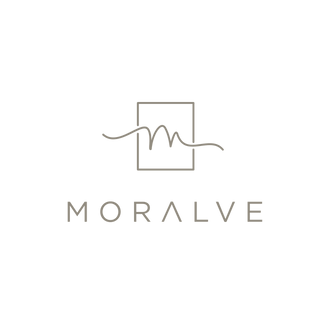

Leave a comment